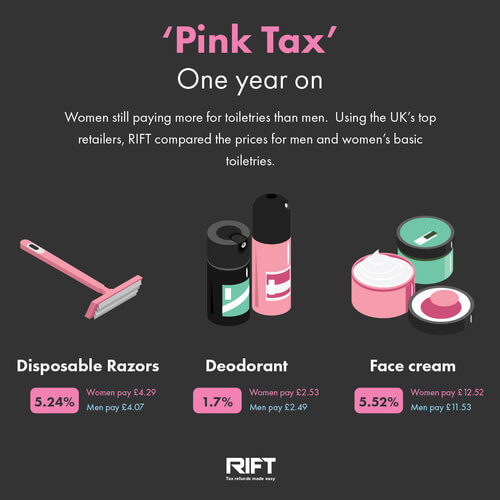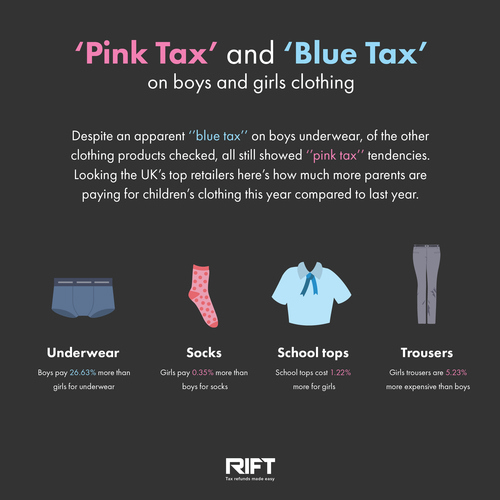Pink Tax One Year On
29th July 2019
Remember last year when we talked about the dreaded “Pink Tax”? In case you need a refresher, it's the baffling reality where women are charged more than men for basically the same stuff. The Lib Dems’ Gender-based Pricing (Prohibition) Bill 2017-19 is still working its way through the House of Commons. Until (and unless) it goes through, though, there’s very little stopping shops from hiking up their prices on things targeted specifically at women - and it’s actually pretty shocking how often they’re are being asked to pay more.
When RIFT looked at this last year, we checked a range of common household products for differences between the versions aimed at women compared to men. Here’s a reminder of what we found:
- Disposable razors cost an average of 6.28% more for women.
- Women’s deodorants were 10.63% more expensive than men’s.
- Women were being charged an incredible 34.28% more than men for moisturising face creams.
When we looked into children’s clothing, it became clear that the trend toward charging females more starts early in life. Taking figures from 4 of the UK’s biggest clothing retailers, we found:
- Girls’ underwear cost an average of 5.8% more than boys’.
- Socks for girls were 2.6% more expensive.
- Girls’ school tops and trousers were 2.73% and 1.3% more expensive, respectively.
In the last year, we’ve talked about the Pink Tax quite a lot – and it goes much further than just deodorants and face creams. Everything from holiday essentials like travel kits and slip-on sandals to critical Personal Protective Equipment (PPE) for construction workers are affected – sometimes by as much as 25%.
Think about that for a moment. In some cases, we’re talking about items that literally safeguard people’s lives here. For women in high-risk occupations, getting the right equipment isn’t as simple as buying the men’s version one size smaller. Items like full-arrest harnesses need to be extremely high-precision, and have to be specifically made to fit women’s body proportions. Across all traditionally male-dominated industries, women are stepping up in the workplace – but so far, pricing strategies simply haven’t been keeping up.
In October 2018, Defence Secretary Gavin Williamson announced the opening up of infantry roles to women. It was a huge step forward for the Armed Forces. Meanwhile, by contrast, NASA was forced to cancel its first all-female spacewalk because they didn’t have enough spacesuits in the right size. With 15% of UK employers not even providing women with the specialised gear the law requires them to, the Pink Tax can be a serious problem.
So, one year on, we took a fresh look at where things stand. Once again, we checked a variety of products offered by national retailers and crunched the numbers. Here’s what we came up with:
Disposable Razors
- Average price for women : £4.29
- Average price for men: £4.07
- Percent difference: 5.24%
Compared to 2018, the gap here has definitely narrowed. Both men and women's razors are more expensive now, though, with a price increase of 27% for women and 28% for men.
Deodorant
- Average price for women: £2.53
- Average price for men: £2.49
- Percent difference: 1.7%
Again, the gap we’re seeing here has lessened. As with the cost of razors, though, both prices have still increased – by 22% for women and 32% for men.
Face cream
- Average price for women: £12.52
- Average price for men: £11.53
- Percent difference: 5.52%

Here’s where we see the biggest difference compared to 2018. Although women's products are on average still around 5% more expensive, last year the gap was a massive 34%. While that sounds impressive, it largely comes down to a significant hike in the prices for men, rather than a reduction in the cost paid by women. The average price of women's moisturising products has still increased by 16%, but men's products have rocketed up by almost 44%.
When we looked at children’s clothing, we checked. Here, we saw the following averages:
- Boys pay 20.36% more than girls for underwear.
- Girls pay 0.35% more than boys for socks.
- School tops cost 1.22% more for girls.
- Girls’ trousers are 5.23% more expensive than boys’.

The weird one here is underwear, with a pretty hefty apparent “Blue Tax” in effect. However, most of that’s down to how many “labels” are aimed at teenage boys, which bumps up the prices. 3 out of 4 products still showed Pink Tax tendencies to some extent.
So - the Pink Tax gaps are narrowing in some places, but it doesn’t look like it’ll be going anywhere for now. Obviously, we’ve got that Lib Dem bill to look forward to once the Commons have finished kicking it around. In the meantime, though, your best defence is still a tax rebate from HMRC. Get in touch with RIFT to get your claim rolling – and stop leaving the cash you’re owed on the taxman’s table.
